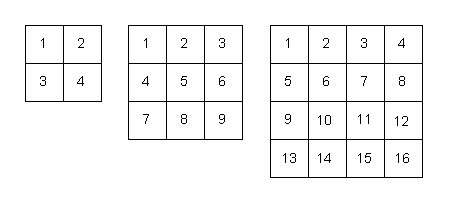The so-called 'square numbers'
Our persistence in using the square as the default unit-of-area in mathematics seems to be symptomatic of our square-sighted view of a special class of number whose very name, although indisputably logical in what it affirms, has blinkered our vision of their multifaceted symmetry. These special numbers are currently (and unfortunately) known simply as , 'the squares' .
 |
In the light of scale-structure theory, this name is not only 'square-sighted' but is short-sighted since as we shall see, these numbers are much more than simply square.
Perhaps a reason the polymorphic nature of these numbers was largely missed was that early exploration of the properties of numbers often involved the arrangement of pebbles into simple geometric shapes. The stones corresponded to the vertices or points of a geometric grid and these points also mapped out empty intervening geometric shapes. In the case of the square arrangement of stones, there is a curious synchronicity between the number of vertices (stones) and the number of intervening square spaces they map out (click buttons a and b in the diagram at left). 9 stones enclose 4 squares (as depicted in diagram), 16 stones enclose 9 squares, 25 stones enclose 16 squares, etc. The numbers are from the same set, and are 'in phase' but separated by one cycle. Thus no matter whether you counted the grid points or the intervening squares, you always got a number from the set {4, 9, 16, 25, ...} Whereas, a triangular grid yielded different numbers of stones (3, 6, 10, ...). Hence these latter were named 'triangular numbers'. It made perfect sense from that one point of view — the number of points or stones in the grid — but if you looked at the number of intervening empty triangular spaces mapped out by the triangular grid of stones, there was a surprising and beautiful connection. Namely, for any given side-length, the number of enclosed self-similar shapes was identical in both the square and triangular formats (refer to interactive diagram above, button b).
The numerous symmetries of these amazing numbers (hitherto known as the squares) seems to have eluded many and remained largely unexplored, ignored, or of anecdotal interest for more than two thousand years. Very early in the history of mathematics, triangular numbers and square numbers became defined entities, distinct sets with distinct properties. The nomenclature was biased in favour of difference: 'How does this set differ from that set?' This emphasis on taxonomy (naming and cataloguing things) has affirmed connections at one level, but frequently at the expense of recognising (often more important) connections on other levels. This has also affected the arts.
Our 'square glasses' ensured that we would continue to see square numbers in square ways.
| back to top |
next > |